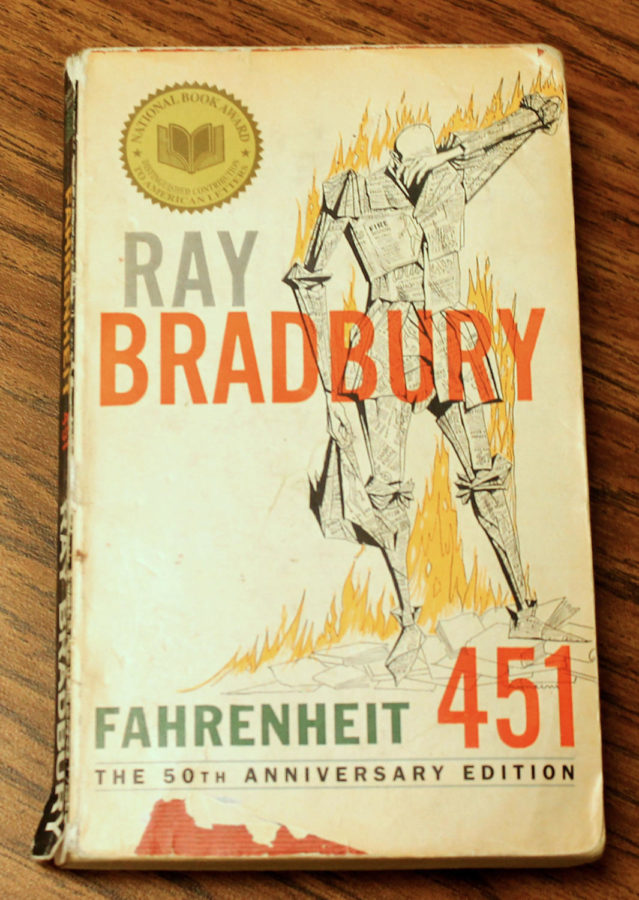Reading at the Ridge: Fahrenheit 451
January 18, 2019
Required Reading. You may smile, you may groan, you may have any number of reactions, but with the right book, even the most reluctant reader can find the assignment worthwhile.
“The right book” could be Ray Bradbury’s cautionary tale Fahrenheit 451.
Sophomores across campus have spent the last two months reading Fahrenheit as part of their English class curriculum. I had heard of Fahrenheit 451, but dystopian fiction isn’t a genre I typically read, so I hadn’t picked up the book before our assignment. As my class flipped through the opening pages, I was interested to see what the famous novel had in store.
Fahrenheit 451 follows the life of main character Guy Montag. Guy is a fireman, a career path that – in this distorted society – mainly involves setting books on fire as well as the houses where the illegal books are found. Aside from this very abnormal profession that has been normalized, Guy lives a pretty mundane life. He spends time with his wife, Mildred, who’s completely obsessed with the giant interactive TV screens on their walls, and doing what’s expected of him by the government. He doesn’t question much of what he does until he meets his new neighbor, a teenage girl named Clarisse who lives her life as an individual and non-conformist. She asks Guy an unusual question that becomes the catalyst for his own self-discovery and transformation: “Are you happy?”
Fahrenheit 451 had a compelling story with plenty of action, as well as a good pace that kept the story going and readers guessing. For a novel that was published in 1953, the story is uncannily similar to our lives today and it is both relevant and relatable. From the interactive screens that can be likened to Skype to the “Seashell” devices that characters wear in their ears to distract them from the real world, much of the novel was a fantastical idea at a time when TVs had barely been invented. Yet some of Bradbury’s “figments of the imagination” have actually become fixtures of today’s world.
Another element of the novel I found interesting was the idea that the citizens’ lack of privacy came from their own choice to surrender the responsibility of thinking for themselves. In other sci-fi stories I’ve read, it’s generally the government of the dystopian society that takes the away the people’s decision-making by force. Fahrenheit 451, however, calls readers to action with the theme that by entrusting their entire lives to Siri or Alexa, they’re depriving themselves of freedom and choice.
When you close the back cover for the last time and remove your bookmark, you’ll be glad you read this book. Still, some parts of the story can get a bit frightening or disturbing, so if you don’t like the idea of scary stories at night, Fahrenheit may not be optimal bedtime reading; save it for the daytime. You’ll be happy when you don’t have visions of Mechanical Hounds dancing through your head as they peer through your windows in the dark– yikes.
If you’re a big dystopian or science fiction fan, Fahrenheit might just become your next favorite. If you love literature or classics that you can really get into and analyze, Bradbury’s masterpiece will likely leave your mind buzzing with theme and figurative language for days afterwards.
Sometimes, required reading is seen as a chore, but, for me, being assigned to read Fahrenheit 451 gave me a reason to step outside of my figurative “reading comfort zone” and led me to find a new favorite in a different genre. While everyone may not find it as riveting, for me, Fahrenheit held just about everything you could want in a book: strong character development, a touch of mystery, every character served a purpose in the story and the whole novel struck that perfect balance between the soliloquy-like main character’s stream of thoughts, and the need for plot development with a brisk pace. All of this on top of a story seemingly written for our world today and what you get is a great piece of speculative fiction that hardly feels like required reading.




